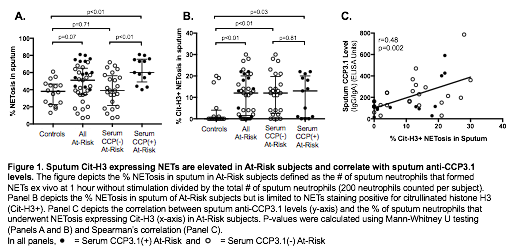Session Information
Date: Wednesday, October 24, 2018
Title: 6W009 ACR Abstract: RA–Etiology & Pathogenesis II (2898–2903)
Session Type: ACR Concurrent Abstract Session
Session Time: 9:00AM-10:30AM
Background/Purpose: Our group previously demonstrated that anti-citrullinated (cit) protein antibodies (ACPA) in the sputum correlate with remnants of neutrophil extracellular traps (NETs) in RA-free subjects At-Risk for future RA. Sputum neutrophils from these subjects also had increased ex vivo NET formation (NETosis) (Okamoto ACR 2017). However, it is unknown what specific features these sputum NETs contain and how they relate to inflammation and ACPA production in the lung. Of note, NETs variably contain cit proteins that can be targets of ACPA. Herein, we explored associations between ACPA and cit-histone H3 (cit-H3) in sputum NETs and local cytokines in the lung.
Methods: In 32 At-Risk subjects without synovitis yet At-Risk for RA because they were first-degree relatives (FDR) of RA patients (N=29) or serum ACPA(+) [N=13, 5/13 also FDRs] and in 16 serum ACPA(-) non-FDR healthy controls, we tested serum and induced sputum for ACPA using anti-cyclic cit peptide (CCP) ELISA (CCP3.1 IgG/IgA, Inova). After incubation of sputum plugs for 1 hour without stimulation followed by staining with Hoechst 33342, anti-myeloperoxidase (MPO) and anti-cit-H3, we determined sputum neutrophils that had formed NETs ex vivo by microscopy. Separately, in sputum cell-free supernatant, the level of NET remnants was quantified by sandwich ELISA for the NET-specific protein complex DNA-cit-H3, and the levels of IL-1β, IL-4, IL-6, IL-8, IL-10, TNFα and IFNγ were measured by Meso Scale Discovery assay.
Results: The % of sputum neutrophils that formed NETs was higher in serum CCP(+) At-Risk but not serum CCP(-) At-Risk subjects compared to controls (Figure 1A). However, the % of sputum neutrophils that formed NETs specifically expressing cit-H3 was higher in all At-Risk subjects (Figure 1B). In all At-Risk subjects, sputum anti-CCP levels significantly correlated with formation of cit-H3 containing NETs (Figure 1C) but not overall sputum NETosis. NET remnants containing DNA-Cit-H3 complexes also significantly correlated with sputum anti-CCP level (r=0.80, p<0.001). After accounting for multiple comparisons, sputum anti-CCP and DNA-cit-H3 levels significantly correlated with sputum levels of IL-6, IL-8, IL-10 and TNFα (Figure 2).
Conclusion: Sputum neutrophils in At-Risk subjects demonstrate increased cit-H3 expressing NETs that strongly correlate with sputum anti-CCP and multiple cytokines. These findings suggest that cit-H3-expressing NETosis in the lung may play a role in the development of ACPA. Additional studies are needed to determine associations with transitions to systemic ACPA and classified RA.
To cite this abstract in AMA style:
Okamoto Y, Seto NL, Kaplan MJ, Visser A, Norris JM, Deane KD, Holers VM, Demoruelle MK. Sputum Neutrophils from Individuals at-Risk for RA Demonstrate Increased Citrullinated Histone H3 Containing Neutrophil Extracellular Traps That Correlate with Sputum Anti-Cyclic Citrullinated Peptide Antibody Levels [abstract]. Arthritis Rheumatol. 2018; 70 (suppl 9). https://acrabstracts.org/abstract/sputum-neutrophils-from-individuals-at-risk-for-ra-demonstrate-increased-citrullinated-histone-h3-containing-neutrophil-extracellular-traps-that-correlate-with-sputum-anti-cyclic-citrullinated-peptide/. Accessed .« Back to 2018 ACR/ARHP Annual Meeting
ACR Meeting Abstracts - https://acrabstracts.org/abstract/sputum-neutrophils-from-individuals-at-risk-for-ra-demonstrate-increased-citrullinated-histone-h3-containing-neutrophil-extracellular-traps-that-correlate-with-sputum-anti-cyclic-citrullinated-peptide/


